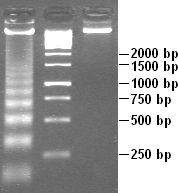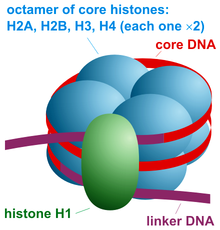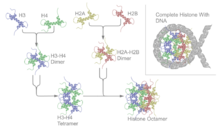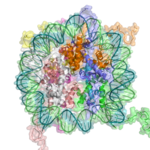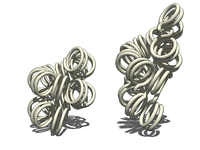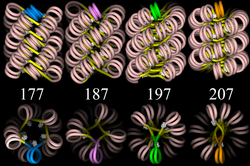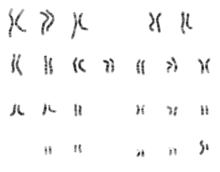A nucleosome is the basic structural unit of DNA packaging in eukaryotes. The structure of a nucleosome consists of a segment of DNA wound around eight histone proteins and resembles thread wrapped around a spool.
DNA must be compacted into nucleosomes to fit within the cell nucleus. In addition to nucleosome wrapping, eukaryotic chromatin is further compacted by being folded into a series of more complex structures, eventually forming a chromosome.
Nucleosomes are thought to carry epigenetically inherited information in the form of covalent modifications of their core histones. Nucleosome positions in the genome are not random, and it is important to know where each nucleosome is located because this determines the accessibility of the DNA to regulatory proteins.
Nucleosomes were first observed as particles in the electron microscope by Don and Ada Olins in 1974, and their existence and structure (as histone octamers surrounded by approximately 200 base pairs of DNA) were proposed by Roger Kornberg. The role of the nucleosome as a general gene repressor was demonstrated by Lorch et al. in vitro, and by Han and Grunstein in vivo in 1987 and 1988, respectively.
The nucleosome core particle consists of approximately 146 base pairs (bp) of DNA wrapped in 1.67 left-handed superhelical turns around a histone octamer, consisting of 2 copies each of the core histones H2A, H2B, H3, and H4. Core particles are connected by stretches of linker DNA, which can be up to about 80 bp long. Technically, a nucleosome is defined as the core particle plus one of these linker regions; however the word is often synonymous with the core particle. Genome-wide nucleosome positioning maps are now available for many model organisms including mouse liver and brain.
Linker histones such as H1 and its isoforms are involved in chromatin compaction and sit at the base of the nucleosome near the DNA entry and exit binding to the linker region of the DNA. Non-condensed nucleosomes without the linker histone resemble "beads on a string of DNA" under an electron microscope.
In contrast to most eukaryotic cells, mature sperm cells largely use protamines to package their genomic DNA, most likely to achieve an even higher packaging ratio. Histone equivalents and a simplified chromatin structure have also been found in Archaea, suggesting that eukaryotes are not the only organisms that use nucleosomes.
DNA must be compacted into nucleosomes to fit within the cell nucleus. In addition to nucleosome wrapping, eukaryotic chromatin is further compacted by being folded into a series of more complex structures, eventually forming a chromosome.
Nucleosomes are thought to carry epigenetically inherited information in the form of covalent modifications of their core histones. Nucleosome positions in the genome are not random, and it is important to know where each nucleosome is located because this determines the accessibility of the DNA to regulatory proteins.
Nucleosomes were first observed as particles in the electron microscope by Don and Ada Olins in 1974, and their existence and structure (as histone octamers surrounded by approximately 200 base pairs of DNA) were proposed by Roger Kornberg. The role of the nucleosome as a general gene repressor was demonstrated by Lorch et al. in vitro, and by Han and Grunstein in vivo in 1987 and 1988, respectively.
The nucleosome core particle consists of approximately 146 base pairs (bp) of DNA wrapped in 1.67 left-handed superhelical turns around a histone octamer, consisting of 2 copies each of the core histones H2A, H2B, H3, and H4. Core particles are connected by stretches of linker DNA, which can be up to about 80 bp long. Technically, a nucleosome is defined as the core particle plus one of these linker regions; however the word is often synonymous with the core particle. Genome-wide nucleosome positioning maps are now available for many model organisms including mouse liver and brain.
Linker histones such as H1 and its isoforms are involved in chromatin compaction and sit at the base of the nucleosome near the DNA entry and exit binding to the linker region of the DNA. Non-condensed nucleosomes without the linker histone resemble "beads on a string of DNA" under an electron microscope.
In contrast to most eukaryotic cells, mature sperm cells largely use protamines to package their genomic DNA, most likely to achieve an even higher packaging ratio. Histone equivalents and a simplified chromatin structure have also been found in Archaea, suggesting that eukaryotes are not the only organisms that use nucleosomes.
Structure
Structure of the core particle
The crystal structure of the nucleosome core particle consisting of H2A , H2B , H3 and H4 core histones, and DNA. The view is from the top through the superhelical axis.
Overview
Pioneering
structural studies in the 1980s by Aaron Klug's group provided the
first evidence that an octamer of histone proteins wraps DNA around
itself in about 1.7 turns of a left-handed superhelix. In 1997 the first near atomic resolution crystal structure
of the nucleosome was solved by the Richmond group, showing the most
important details of the particle. The human alpha-satellite palindromic
DNA critical to achieving the 1997 nucleosome crystal structure was
developed by the Bunick group at Oak Ridge National Laboratory in
Tennessee. The structures of over 20 different nucleosome core particles have been solved to date,
including those containing histone variants and histones from different
species. The structure of the nucleosome core particle is remarkably
conserved, and even a change of over 100 residues between frog and yeast
histones results in electron density maps with an overall root mean square deviation of only 1.6Å.
The nucleosome core particle (NCP)
The nucleosome core particle (shown in the figure) consists of about 146 base pair of DNA wrapped in 1.67 left-handed superhelical turns around the histone octamer, consisting of 2 copies each of the core histones H2A, H2B, H3, and H4. Adjacent nucleosomes are joined by a stretch of free DNA termed linker DNA (which varies from 10 - 80 bp in length depending on species and tissue type).The whole structure generates a cylinder of diameter 11 nm and a height of 5.5 nm.
Apoptotic DNA laddering. Digested chromatin is in the first lane; the second contains DNA standard to compare lengths.
Scheme of nucleosome organization.
Nucleosome core particles are observed when chromatin in interphase
is treated to cause the chromatin to unfold partially. The resulting
image, via an electron microscope, is "beads on a string". The string is
the DNA, while each bead in the nucleosome is a core particle. The
nucleosome core particle is composed of DNA and histone proteins.
Partial DNAse digestion of chromatin
reveals its nucleosome structure. Because DNA portions of nucleosome
core particles are less accessible for DNAse than linking sections, DNA
gets digested into fragments of lengths equal to multiplicity of
distance between nucleosomes (180, 360, 540 base pairs etc.). Hence a
very characteristic pattern similar to a ladder is visible during gel electrophoresis of that DNA. Such digestion can occur also under natural conditions during apoptosis ("cell suicide" or programmed cell death), because autodestruction of DNA typically is its role.
Protein interactions within the nucleosome
The
core histone proteins contains a characteristic structural motif termed
the "histone fold", which consists of three alpha-helices (α1-3)
separated by two loops (L1-2). In solution, the histones form H2A-H2B
heterodimers and H3-H4 heterotetramers. Histones dimerise about their
long α2 helices in an anti-parallel orientation, and, in the case of H3
and H4, two such dimers form a 4-helix bundle stabilised by extensive
H3-H3’ interaction. The H2A/H2B dimer binds onto the H3/H4 tetramer due
to interactions between H4 and H2B, which include the formation of a
hydrophobic cluster.
The histone octamer is formed by a central H3/H4 tetramer sandwiched
between two H2A/H2B dimers. Due to the highly basic charge of all four
core histones, the histone octamer is stable only in the presence of DNA
or very high salt concentrations.
Histone - DNA interactions
The nucleosome contains over 120 direct protein-DNA interactions and several hundred water-mediated ones.
Direct protein - DNA interactions are not spread evenly about the
octamer surface but rather located at discrete sites. These are due to
the formation of two types of DNA binding sites within the octamer; the
α1α1 site, which uses the α1 helix from two adjacent histones, and the
L1L2 site formed by the L1 and L2 loops. Salt links and hydrogen bonding
between both side-chain basic and hydroxyl groups and main-chain amides
with the DNA backbone phosphates form the bulk of interactions with the
DNA. This is important, given that the ubiquitous distribution of
nucleosomes along genomes requires it to be a non-sequence-specific
DNA-binding factor. Although nucleosomes tend to prefer some DNA
sequences over others,
they are capable of binding practically to any sequence, which is
thought to be due to the flexibility in the formation of these
water-mediated interactions. In addition, non-polar interactions are
made between protein side-chains and the deoxyribose groups, and an
arginine side-chain intercalates into the DNA minor groove at all 14
sites where it faces the octamer surface.
The distribution and strength of DNA-binding sites about the octamer
surface distorts the DNA within the nucleosome core. The DNA is
non-uniformly bent and also contains twist defects. The twist of free
B-form DNA in solution is 10.5 bp per turn. However, the overall twist
of nucleosomal DNA is only 10.2 bp per turn, varying from a value of 9.4
to 10.9 bp per turn.
Histone tail domains
The
histone tail extensions constitute up to 30% by mass of histones, but
are not visible in the crystal structures of nucleosomes due to their
high intrinsic flexibility, and have been thought to be largely
unstructured.
The N-terminal tails of histones H3 and H2B pass through a channel
formed by the minor grooves of the two DNA strands, protruding from the
DNA every 20 bp. The N-terminal
tail of histone H4, on the other hand, has a region of highly basic
amino acids (16-25), which, in the crystal structure, forms an
interaction with the highly acidic surface region of a H2A-H2B dimer of
another nucleosome, being potentially relevant for the higher-order
structure of nucleosomes. This interaction is thought to occur under
physiological conditions also, and suggests that acetylation of the H4 tail distorts the higher-order structure of chromatin.
Higher order structure
The current chromatin compaction model.
The organization of the DNA that is achieved by the nucleosome cannot
fully explain the packaging of DNA observed in the cell nucleus.
Further compaction of chromatin into the cell nucleus is necessary, but is not yet well understood. The current understanding is that repeating nucleosomes with intervening "linker" DNA form a 10-nm-fiber, described as "beads on a string", and have a packing ratio of about five to ten. A chain of nucleosomes can be arranged in a 30 nm fiber, a compacted structure with a packing ratio of ~50 and whose formation is dependent on the presence of the H1 histone.
A crystal structure of a tetranucleosome has been presented and
used to build up a proposed structure of the 30 nm fiber as a two-start
helix.
There is still a certain amount of contention regarding this model, as it is incompatible with recent electron microscopy data.
Beyond this, the structure of chromatin is poorly understood, but it
is classically suggested that the 30 nm fiber is arranged into loops
along a central protein scaffold to form transcriptionally active euchromatin. Further compaction leads to transcriptionally inactive heterochromatin.
Dynamics
Although
the nucleosome is a very stable protein-DNA complex, it is not static
and has been shown to undergo a number of different structural
re-arrangements including nucleosome sliding and DNA site exposure.
Depending on the context, nucleosomes can inhibit or facilitate
transcription factor binding. Nucleosome positions are controlled by
three major contributions: First, the intrinsic binding affinity of the
histone octamer depends on the DNA sequence. Second, the nucleosome can
be displaced or recruited by the competitive or cooperative binding of
other protein factors. Third, the nucleosome may be actively
translocated by ATP-dependent remodeling complexes.
Nucleosome sliding
Work
performed in the Bradbury laboratory showed that nucleosomes
reconstituted onto the 5S DNA positioning sequence were able to
reposition themselves translationally onto adjacent sequences when
incubated thermally.
Later work showed that this repositioning did not require disruption of
the histone octamer but was consistent with nucleosomes being able to
"slide" along the DNA in cis. In 2008, it was further revealed that CTCF
binding sites act as nucleosome positioning anchors so that, when used
to align various genomic signals, multiple flanking nucleosomes can be
readily identified.
Although nucleosomes are intrinsically mobile, eukaryotes have evolved a
large family of ATP-dependent chromatin remodelling enzymes to alter
chromatin structure, many of which do so via nucleosome sliding. In
2012, Beena Pillai's laboratory has demonstrated that nucleosome sliding
is one of the possible mechanism for large scale tissue specific
expression of genes. The work shows that the transcription start site
for genes expressed in a particular tissue, are nucleosome depleted
while, the same set of genes in other tissue where they are not
expressed, are nucleosome bound.
DNA site exposure
Work
from the Widom laboratory has shown that nucleosomal DNA is in
equilibrium between a wrapped and unwrapped state. Measurements of these
rates using time-resolved FRET
revealed that DNA within the nucleosome remains fully wrapped for only
250 ms before it is unwrapped for 10-50 ms and then rapidly rewrapped.
This implies that DNA does not need to be actively dissociated from the
nucleosome but that there is a significant fraction of time during
which it is fully accessible. Indeed, this can be extended to the
observation that introducing a DNA-binding sequence within the
nucleosome increases the accessibility of adjacent regions of DNA when
bound.
This propensity for DNA within the nucleosome to “breathe” has
important functional consequences for all DNA-binding proteins that
operate in a chromatin environment. In particular, the dynamic breathing of nucleosomes plays an important role in restricting the advancement of RNA polymerase II during transcription elongation.
Nucleosome free region
Promoters
of active genes have nucleosome free regions (NFR). This allows for
promoter DNA accessibility to various proteins, such as transcription
factors. Nucleosome free region typically spans for 200 nucleotides in S. cerevisae.
Well-positioned nucleosomes form boundaries of NFR. These nucleosomes
are called +1-nucleosome and −1-nucleosome and are located at canonical
distances downstream and upstream, respectively, from transcription
start site. +1-nucleosome and several downstream nucleosomes also tend to incorporate H2A.Z histone variant.
Modulating nucleosome structure
Eukaryotic
genomes are ubiquitously associated into chromatin; however, cells must
spatially and temporally regulate specific loci independently of bulk
chromatin. In order to achieve the high level of control required to
co-ordinate nuclear processes such as DNA replication, repair, and
transcription, cells have developed a variety of means to locally and
specifically modulate chromatin structure and function. This can involve
covalent modification of histones, the incorporation of histone
variants, and non-covalent remodelling by ATP-dependent remodeling
enzymes.
Histone post-translational modifications
Since they were discovered in the mid-1960s, histone modifications have been predicted to affect transcription.
The fact that most of the early post-translational modifications found
were concentrated within the tail extensions that protrude from the
nucleosome core lead to two main theories regarding the mechanism of
histone modification. The first of the theories suggested that they may
affect electrostatic interactions between the histone tails and DNA to
“loosen” chromatin structure. Later it was proposed that combinations of
these modifications may create binding epitopes with which to recruit
other proteins.
Recently, given that more modifications have been found in the
structured regions of histones, it has been put forward that these
modifications may affect histone-DNA and histone-histone
interactions within the nucleosome core. Modifications (such as
acetylation or phosphorylation) that lower the charge of the globular
histone core are predicted to "loosen" core-DNA association; the
strength of the effect depends on location of the modification within
the core.
Some modifications have been shown to be correlated with gene silencing;
others seem to be correlated with gene activation. Common modifications
include acetylation, methylation, or ubiquitination of lysine; methylation of arginine; and phosphorylation of serine. The information stored in this way is considered epigenetic,
since it is not encoded in the DNA but is still inherited to daughter
cells. The maintenance of a repressed or activated status of a gene is
often necessary for cellular differentiation.
Histone variants
Although
histones are remarkably conserved throughout evolution, several variant
forms have been identified. This diversification of histone function is
restricted to H2A and H3, with H2B and H4 being mostly invariant. H2A
can be replaced by H2AZ (which leads to reduced nucleosome stability) or H2AX (which is associated with DNA repair and T cell differentiation), whereas the inactive X chromosomes
in mammals are enriched in macroH2A. H3 can be replaced by H3.3 (which
correlates with activate genes and regulatory elements) and in centromeres H3 is replaced by CENPA.
ATP-dependent nucleosome remodeling
A
number of distinct reactions are associated with the term ATP-dependent
chromatin remodeling. Remodeling enzymes have been shown to slide
nucleosomes along DNA, disrupt histone-DNA contacts to the extent of destabilizing the H2A/H2B dimer and to generate negative superhelical torsion in DNA and chromatin. Recently, the Swr1 remodeling enzyme has been shown to introduce the variant histone H2A.Z into nucleosomes.
At present, it is not clear if all of these represent distinct
reactions or merely alternative outcomes of a common mechanism. What is
shared between all, and indeed the hallmark of ATP-dependent chromatin
remodeling, is that they all result in altered DNA accessibility.
Studies looking at gene activation in vivo and, more astonishingly, remodeling in vitro
have revealed that chromatin remodeling events and transcription-factor
binding are cyclical and periodic in nature. While the consequences of
this for the reaction mechanism of chromatin remodeling are not known,
the dynamic nature of the system may allow it to respond faster to
external stimuli. A recent study indicates that nucleosome positions
change significantly during mouse embryonic stem cell development, and
these changes are related to binding of developmental transcription
factors.
Dynamic nucleosome remodelling across the Yeast genome
Studies in 2007 have catalogued nucleosome positions in yeast and shown that nucleosomes are depleted in promoter regions and origins of replication.
About 80% of the yeast genome appears to be covered by nucleosomes and the pattern of nucleosome positioning clearly relates to DNA regions that regulate transcription, regions that are transcribed and regions that initiate DNA replication. Most recently, a new study examined dynamic changes
in nucleosome repositioning during a global transcriptional
reprogramming event to elucidate the effects on nucleosome displacement
during genome-wide transcriptional changes in yeast (Saccharomyces cerevisiae). The results suggested that nucleosomes that were localized to promoter regions are displaced in response to stress (like heat shock).
In addition, the removal of nucleosomes usually corresponded to
transcriptional activation and the replacement of nucleosomes usually
corresponded to transcriptional repression, presumably because transcription factor
binding sites became more or less accessible, respectively. In general,
only one or two nucleosomes were repositioned at the promoter to effect
these transcriptional changes. However, even in chromosomal regions
that were not associated with transcriptional changes, nucleosome
repositioning was observed, suggesting that the covering and uncovering
of transcriptional DNA does not necessarily produce a transcriptional
event. After transcription, the rDNA region has to protected from any
damage, it suggested HMGB proteins play a major role in protecting the
nucleosome free region.
Nucleosome assembly in vitro
Diagram of nucleosome assembly.
Nucleosomes can be assembled in vitro by either using purified native or recombinant histones. One standard technique of loading the DNA around the histones involves the use of salt dialysis.
A reaction consisting of the histone octamers and a naked DNA template
can be incubated together at a salt concentration of 2 M. By steadily
decreasing the salt concentration, the DNA will equilibrate to a
position where it is wrapped around the histone octamers, forming
nucleosomes. In appropriate conditions, this reconstitution process
allows for the nucleosome positioning affinity of a given sequence to be
mapped experimentally.
Disulfide crosslinked nucleosome core particles
A recent advance in the production of nucleosome core particles with enhanced stability involves site-specific disulfide crosslinks. Two different crosslinks can be introduced into the nucleosome core particle. A first one crosslinks the two copies of H2A via an introduced cysteine (N38C) resulting in histone octamer
which is stable against H2A/H2B dimer loss during nucleosome
reconstitution. A second crosslink can be introduced between the H3
N-terminal histone tail and the nucleosome DNA ends via an incorporated
convertible nucleotide.
The DNA-histone octamer crosslink stabilizes the nucleosome core
particle against DNA dissociation at very low particle concentrations
and at elevated salt concentrations.
Nucleosome assembly in vivo
Nucleosomes
are the basic packing unit of DNA built from histone proteins around
which DNA is coiled. They serve as a scaffold for formation of higher
order chromatin structure as well as for a layer of regulatory control
of gene expression. Nucleosomes are quickly assembled onto newly
synthesized DNA behind the replication fork.
H3 and H4
Histones H3 and H4 from disassembled old nucleosomes are kept in the vicinity and randomly distributed on the newly synthesized DNA. They are assembled by the chromatin assembly factor-1 (CAF-1) complex, which consists of three subunits (p150, p60, and p48).
Newly synthesized H3 and H4 are assembled by the replication coupling
assembly factor (RCAF). RCAF contains the subunit Asf1, which binds to
newly synthesized H3 and H4 proteins.
The old H3 and H4 proteins retain their chemical modifications which
contributes to the passing down of the epigenetic signature. The newly
synthesized H3 and H4 proteins are gradually acetylated at different
lysine residues as part of the chromatin maturation process.
It is also thought that the old H3 and H4 proteins in the new
nucleosomes recruit histone modifying enzymes that mark the new
histones, contributing to epigenetic memory.
H2A and H2B
In contrast to old H3 and H4, the old H2A and H2B
histone proteins are released and degraded; therefore, newly assembled
H2A and H2B proteins are incorporated into new nucleosomes.
H2A and H2B are assembled into dimers which are then loaded onto
nucleosomes by the nucleosome assembly protein-1 (NAP-1) which also
assists with nucleosome sliding.
The nucleosomes are also spaced by ATP-dependent nucleosome-remodeling
complexes containing enzymes such as Isw1 Ino80, and Chd1, and
subsequently assembled into higher order structure.

